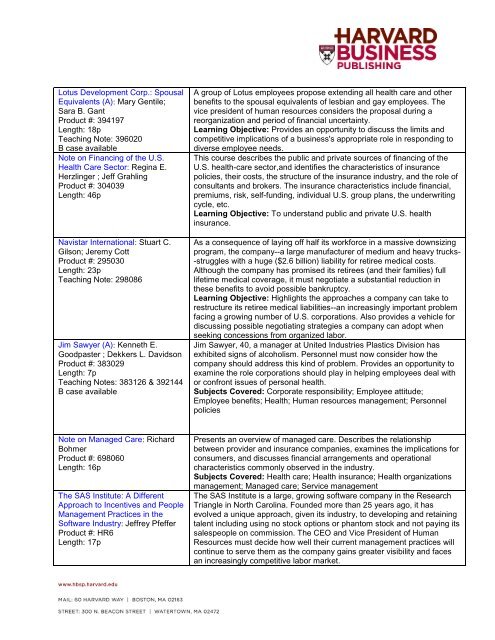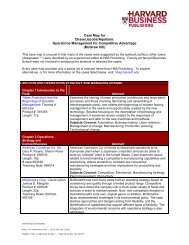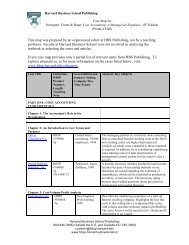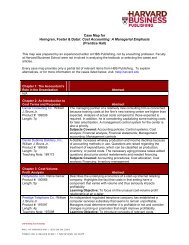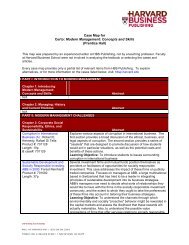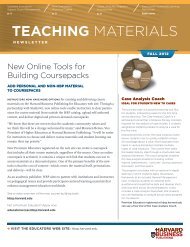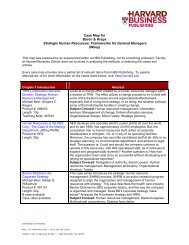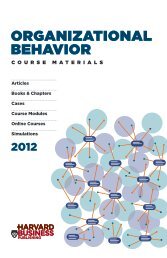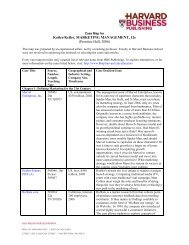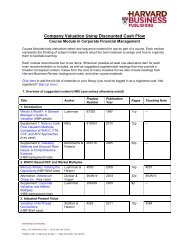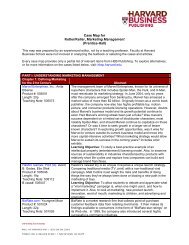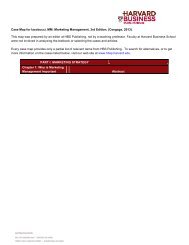Case Map for Noe, Hollenbeck, Gerhart & Wright - Harvard Business ...
Case Map for Noe, Hollenbeck, Gerhart & Wright - Harvard Business ...
Case Map for Noe, Hollenbeck, Gerhart & Wright - Harvard Business ...
Create successful ePaper yourself
Turn your PDF publications into a flip-book with our unique Google optimized e-Paper software.
Lotus Development Corp.: Spousal<br />
Equivalents (A): Mary Gentile;<br />
Sara B. Gant<br />
Product #: 394197<br />
Length: 18p<br />
Teaching Note: 396020<br />
B case available<br />
Note on Financing of the U.S.<br />
Health Care Sector: Regina E.<br />
Herzlinger ; Jeff Grahling<br />
Product #: 304039<br />
Length: 46p<br />
Navistar International: Stuart C.<br />
Gilson; Jeremy Cott<br />
Product #: 295030<br />
Length: 23p<br />
Teaching Note: 298086<br />
Jim Sawyer (A): Kenneth E.<br />
Goodpaster ; Dekkers L. Davidson<br />
Product #: 383029<br />
Length: 7p<br />
Teaching Notes: 383126 & 392144<br />
B case available<br />
Note on Managed Care: Richard<br />
Bohmer<br />
Product #: 698060<br />
Length: 16p<br />
The SAS Institute: A Different<br />
Approach to Incentives and People<br />
Management Practices in the<br />
Software Industry: Jeffrey Pfeffer<br />
Product #: HR6<br />
Length: 17p<br />
A group of Lotus employees propose extending all health care and other<br />
benefits to the spousal equivalents of lesbian and gay employees. The<br />
vice president of human resources considers the proposal during a<br />
reorganization and period of financial uncertainty.<br />
Learning Objective: Provides an opportunity to discuss the limits and<br />
competitive implications of a business's appropriate role in responding to<br />
diverse employee needs.<br />
This course describes the public and private sources of financing of the<br />
U.S. health-care sector,and identifies the characteristics of insurance<br />
policies, their costs, the structure of the insurance industry, and the role of<br />
consultants and brokers. The insurance characteristics include financial,<br />
premiums, risk, self-funding, individual U.S. group plans, the underwriting<br />
cycle, etc.<br />
Learning Objective: To understand public and private U.S. health<br />
insurance.<br />
As a consequence of laying off half its work<strong>for</strong>ce in a massive downsizing<br />
program, the company--a large manufacturer of medium and heavy trucks-<br />
-struggles with a huge ($2.6 billion) liability <strong>for</strong> retiree medical costs.<br />
Although the company has promised its retirees (and their families) full<br />
lifetime medical coverage, it must negotiate a substantial reduction in<br />
these benefits to avoid possible bankruptcy.<br />
Learning Objective: Highlights the approaches a company can take to<br />
restructure its retiree medical liabilities--an increasingly important problem<br />
facing a growing number of U.S. corporations. Also provides a vehicle <strong>for</strong><br />
discussing possible negotiating strategies a company can adopt when<br />
seeking concessions from organized labor.<br />
Jim Sawyer, 40, a manager at United Industries Plastics Division has<br />
exhibited signs of alcoholism. Personnel must now consider how the<br />
company should address this kind of problem. Provides an opportunity to<br />
examine the role corporations should play in helping employees deal with<br />
or confront issues of personal health.<br />
Subjects Covered: Corporate responsibility; Employee attitude;<br />
Employee benefits; Health; Human resources management; Personnel<br />
policies<br />
Presents an overview of managed care. Describes the relationship<br />
between provider and insurance companies, examines the implications <strong>for</strong><br />
consumers, and discusses financial arrangements and operational<br />
characteristics commonly observed in the industry.<br />
Subjects Covered: Health care; Health insurance; Health organizations<br />
management; Managed care; Service management<br />
The SAS Institute is a large, growing software company in the Research<br />
Triangle in North Carolina. Founded more than 25 years ago, it has<br />
evolved a unique approach, given its industry, to developing and retaining<br />
talent including using no stock options or phantom stock and not paying its<br />
salespeople on commission. The CEO and Vice President of Human<br />
Resources must decide how well their current management practices will<br />
continue to serve them as the company gains greater visibility and faces<br />
an increasingly competitive labor market.


